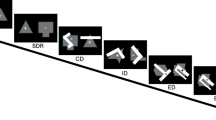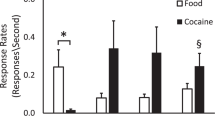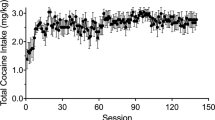Abstract
Individual differences in response to social stress and environmental enrichment may contribute to variability in response to behavioral and pharmacological treatments for drug addiction. In monkeys, social status influences the reinforcing effects of cocaine and the effects of some drugs on cocaine self-administration. In this study, we used male cynomolgus macaques (n=15) living in established social groups to examine the effects of social confrontation on the reinforcing effects of cocaine using a food-drug choice procedure. On the test day, a dominant or subordinate monkey was removed from his homecage and placed into another social pen; 30 min later he was studied in a cocaine-food choice paradigm. For the group, following social confrontation, sensitivity to cocaine reinforcement was significantly greater in subordinate monkeys compared with dominant animals. Examining individual-subject data revealed that for the majority of monkeys (9/15), serving as an intruder in another social group affected cocaine self-administration and these effects were dependent on the social rank of the monkey. For subordinate monkeys, sensitivity to the reinforcing effects of cocaine increased while sensitivity decreased in dominant monkeys. To investigate potential mechanisms mediating these effects, brain glucose metabolism was studied in a subset of monkeys (n=8) using [18F]fluorodeoxyglucose ([18F]FDG) with positron emission tomography. Dominant and subordinate monkeys displayed distinctly different patterns of brain glucose metabolism in their homecage, including areas associated with vigilance and stress/anxiety, respectively, and during social confrontation. These data demonstrate that, depending on an individual’s social status, the same social experience can have divergent effects on brain function and cocaine self-administration. These phenotypic differences in response to social conditions support a personalized treatment approach to cocaine addiction.
Similar content being viewed by others
Log in or create a free account to read this content
Gain free access to this article, as well as selected content from this journal and more on nature.com
or
References
Boyson CO, Holly EN, Burke AR, Montagud-Romero S, DeBold JF, Miczek KA (2016). Maladaptive choices by defeated rats: link between rapid approach to social threat and escalated cocaine self-administration. Psychopharmacology 233: 3173–3186.
Collins GT, Witkin JM, Newman AH, Svensson KA, Grundt P, Cao J et al (2005). Dopamine agonist-induced yawning in rats: a dopamine D3 receptor-mediated behavior. J Pharmacol Exp Ther 314: 310–319.
Czoty PW, Gage HD, Nader MA (2010). Differences in D2 dopamine receptor availability and reaction to novelty in socially housed male monkeys during abstinence from cocaine. Psychopharmacology 208: 585–592.
Czoty PW, Gould RW, Nader MA (2009). Relationship between social rank and cortisol and testosterone concentrations in male cynomolgus monkeys (Macaca fascicularis. J Neuroendocrinol 21: 68–76.
Czoty PW, McCabe C, Nader MA (2005). Assessment of the reinforcing strength of cocaine in socially housed monkeys using a choice procedure. J Pharmacol Exp Ther 312: 96–102.
Czoty PW, Morgan D, Shannon EE, Gage HD, Nader MA (2004). Characterization of dopamine D1 and D2 receptor function in socially housed cynomolgus monkeys self-administering cocaine. Psychopharmacology 174: 381–388.
Czoty PW, Nader MA (2012). Individual differences in the effects of environmental stimuli on cocaine choice in socially housed male cynomolgus monkeys. Psychopharmacology 224: 69–79.
Czoty PW, Nader MA (2013). Effects of dopamine D2/D3 receptor ligands on food-cocaine choice in socially housed male cynomolgus monkeys. J Pharmacol Exp Ther 344: 329–338.
Czoty PW, Nader MA (2015). Effects of oral and intravenous administration of buspirone on food-cocaine choice in socially housed male cynomolgus monkeys. Neuropsychopharmacology 40: 1072–1083.
Dalley JW, Fryer TD, Brichard L, Robinsin ES, Theobald DE et al (2007). Nucleus accumbens D2/3 receptors predict trait impulsivity and cocaine reinforcement. Science 315: 1267–1270.
Degenhardt L, Baxter AJ, Lee Y, Hall W, Sara GE, Johns N et al (2014). The global epidemiology and burden of psychostimulant dependence: findings from the Global Burden of Disease Study 2010. Drug Alcohol Dep 137: 36–47.
Dowd JB, Goldman N (2006). Do biomarkers of stress mediate the relation between socioeconomic status and health? J Epidemiol Community Health 60: 633–639.
Economidou D, Pelloux Y, Robbins TW, Dalley JW, Everitt BJ (2009). High impulsivity predicts relapse to cocaine-seeking after punishment-induced abstinence. Biol Psych 15: 851–856.
Fish EW, De Bold JF, Miczek KA (2005). Escalated aggression as a reward: corticosterone and GABA(A) receptor positive modulators in mice. Psychopharmacology 182: 116–127.
Gould RW, Gage HD, Nader MA (2012). Effects of chronic cocaine self-administration on cognition and cerebral glucose utilization in Rhesus monkeys. Biol Psychiatry 72: 856–863.
Heidbreder CA, Newman AH (2010). Current perspectives on selective dopamine D3 receptor antagonists as pharmacotherapeutics for addictions and related disorders. Ann NY Acad Sci 1187: 4–34.
Henry PK, Murnane K, Votaw JR, Howell LL (2010). Acute brain metabolic effects of cocaine in rhesus monkeys with a history of cocaine use. Brain Imaging Behav 4: 212–219.
Hermans EJ, Henckens MJ, Joels M, Fernandez G (2014). Dynamic adaptation of large-scale brain networks in response to acute stressors. Trends Neurosci 37: 304–314.
Kalin NH, Shelton SE, Fox AS, Oakes TR, Davidson RJ (2008). Brain regions associated with the expression and contextual regulation of anxiety in primates. Biol Psychiatry 58: 796–804.
Kaplan JR, Manuck SB, Clarkson TB, Lusso FM, Taub DM (1982). Social status, environment, and atherosclerosis in cynomolgus monkeys. Arteriosclerosis 2: 359–368.
Kendler KS, Gardner CO, Hickman Heron J, Macleod J, Lewis G, Dick DM (2014). Socioeconomic status and alcohol-related behaviors in mid- to late adolescence in the Avon Longitudinal Study of Parents and Children. J. Stud. Alcohol Drugs 75: 541–545.
Kosten TR, Scanley BE, Tucker KA, Oliveto A, Prince C, Sinha R et al (2006). Cue-induced brain activity changes and relapse in cocaine-dependent patients. Neuropsychopharmacology 31: 644–650.
Lynch WJ, Peterson AB, Sanchez V, Abel J, Smith MA (2013). Exercise as a novel treatment for drug addiction: a neurobiological and stage-dependent hypothesis. Neurosci Biobehav Rev 37: 1622–1644.
Martinez D, Orlowska D, Narendran R, Slifstein M, Liu F, Kumar D et al (2010). Dopamine type 2/3 receptor availability in the striatum and social status in human volunteers. Biol Psychiatry 67: 275–278.
McEwen BS (2007). Physiology and neurobiology of stress and adaptation: central role of the brain. Physiol Rev 87: 873–904.
Miczek KA, Covington HE III, Nikulina EM Jr, Hammer RP (2004). Aggression and defeat: persistent effects on cocaine self-administration and gene expression in peptidergic and aminergic mesocorticolimbic circuits. Neurosci Biobehav Rev 27: 787–802.
Miczek KA, Mutschler NH (1996). Activational effects of social stress on IV cocaine self-administration in rats. Psychopharmacology 128: 256–264.
Miczek KA, Yap JJ, Covington HE 3rd (2008). Social stress, therapeutics and drug abuse: preclinical models of escalated and depressed intake. Pharmacol Ther 120: 102–128.
Morgan D, Grant KA, Gage HD, Mach RH, Kaplan JR et al (2002). Social dominance in monkeys: dopamine D2 receptors and cocaine self-administration. Nat Neurosci 5: 169–174.
Morgan D, Grant KA, Prioleau OA, Nader SH, Kaplan JR, Nader MA (2000). Predictors of social status in cynomolgus monkeys (Macaca fascicularis) after group formation. Am J Primatol 52: 115–131.
Nader MA, Czoty PW, Nader SH, Morgan D (2012a). Nonhuman primate models of social behavior and cocaine abuse. Psychopharmacology 224: 57–67.
Nader MA, Nader SH, Czoty PW, Riddick NV, Gage HD et al (2012b). Social dominance in female monkeys: dopamine receptor function and cocaine reinforcement. Biol Psychiatry 72: 414–421.
Niv Y, Daniel R, Geana A, Gershman SJ, Leong YC et al (2015). Reinforcement learning in multidimensional environments relies on attention mechanisms. J Neurosci 35: 8145–8157.
Patrick ME, Wightman P, Schoeni RF, Schulenberg JE (2012). Socioeconomic status and substance use among young adults: a comparison across constructs and drugs. J Stud Alcohol Drugs 73: 772–782.
Porrino LJ, Miller MD, Smith HR, Nader SH, Nader MA (2016). Neural correlates of exposure to cocaine cues in rhesus monkeys: modulation by the dopamine transporter. Biol Psychiatry 80: 702–710.
Riddick NV, Czoty PW, Gage HD, Kaplan JR, Nader SH, Icenhower M et al (2009). Behavioral and neurobiological characteristics influencing social hierarchy formation in female cynomolgus monkeys. Neuroscience 158: 1257–1265..
Sapolsky RM (2005). The influence of social hierarchy on primate health. Science 308: 648–652.
Schuurman T (1980). Hormonal correlates of agonistic behavior in adult male rats. In: McConnel PS, et al. (eds). Progress in Brain Research: Adaptive Capabilities of the Nervous System. Elsevier Biomedical Press: Amsterdam; pp 415–420.
Shimamoto A, Holly EN, Boyson CO, DeBold JF, Miczek KA (2015). Individual differences in anhedonic and accumbal dopamine responses to chronic social stress and their link to cocaine self-administration in female rats. Psychopharmacology 232: 825–834.
Smith MA, Lynch WJ (2012). Exercise as a potential treatment for drug abuse: evidence from preclinical studies. Front. Psychiatry 2: 1–10.
Stairs DJ, Bardo MT (2009). Neurobehavioral effects of environmental enrichment and drug abuse vulnerability. Pharmacol Biochem Behav 92: 377–382.
Stoops WW, Rush CR (2013). Agonist replacement for stimulant dependence: a review of clinical research. Curr Pharm Des 19: 7026–7035.
Van Der Stel J (2015). Precision in addiction care: does it make a difference? Yale J Biol Med 88: 415–422.
Van Hemel PE (1972). Aggression as a reinforcer: operant behavior in the mouse-killing rat. J Exp Anal Behav 17: 237–245.
Verrico CD, Haile CN, Newton TF, Kosten TR, De La Garza R 2nd (2013). Pharmacotherapeutics for substance-use disorders: a focus on dopaminergic medications. Expert Opin Investig Drugs 22: 1549–1568.
Vivian JA, Weerts EM, Miczek KA (1994). Defeat engenders pentylenetetrazole-appropriate responding in rats: antagonism by midazolam. Psychopharmacology 116: 491–498.
Volkow ND, Koob G, Baler R (2015). Biomarkers in substance use disorders. ACS Chem Neurosci 4: 522–525.
Volkow ND, Wang GJ, Fowler JS, Logan J, Gatley SJ et al (1999). Prediction of reinforcing responses to psychostimulants in humans by brain D2 dopamine receptors. Am J Psychiatry 156: 1440–1443.
Wang C, Shen Z, Huang P, Qian W, Yu X, Sun J et al (2016). Altered spontaneous activity of posterior cingulate cortex and superior temporal gyrus are associated with a smoking cessation treatment outcome using varenicline revelaed by regional homogeneity. Brain Imaging Behav (e-pub ahead of print).
Wood SK, Walker HE, Valentino RJ, Bhatnagar S (2010). Individual differences in reactivity to social stress predict susceptibility and resilience to a depressive phenotype: role of corticotropin-releasing factor. Endocrinology 151: 1795–1805.
Yap JJ, Chartoff EH, Holly EN, Potter DN, Carlezon WA Jr, Miczek KA (2015). Social defeat stress-induced sensitization and escalated cocaine self-administration: the role of ERK signaling in the rat ventral tegmental area. Psychopharmacology 232: 1555–1569.
Acknowledgements
We would like to acknowledge the technical assistance of Michelle Bell, Michael Coller, Nicholas Garrett, Mack Miller, Susan Nader, Tonya Calhoun, Hilary Smith, Colleen Hanlon, and Michael Wesley for assistance with image analysis.
Author information
Authors and Affiliations
Corresponding author
Additional information
Supplementary Information accompanies the paper on the Neuropsychopharmacology website
Supplementary information
Rights and permissions
About this article
Cite this article
Gould, R., Czoty, P., Porrino, L. et al. Social Status in Monkeys: Effects of Social Confrontation on Brain Function and Cocaine Self-Administration. Neuropsychopharmacol 42, 1093–1102 (2017). https://doi.org/10.1038/npp.2016.285
Received:
Revised:
Accepted:
Published:
Issue date:
DOI: https://doi.org/10.1038/npp.2016.285
This article is cited by
-
Acquisition of cocaine reinforcement using fixed-ratio and concurrent choice schedules in socially housed female and male monkeys
Psychopharmacology (2024)
-
Neuroscience in addiction research
Journal of Neural Transmission (2024)
-
PET imaging of kappa opioid receptors and receptor expression quantified in neuron-derived extracellular vesicles in socially housed female and male cynomolgus macaques
Neuropsychopharmacology (2023)
-
Effects of social reorganization on dopamine D2/D3 receptor availability and cocaine self-administration in male cynomolgus monkeys
Psychopharmacology (2017)



